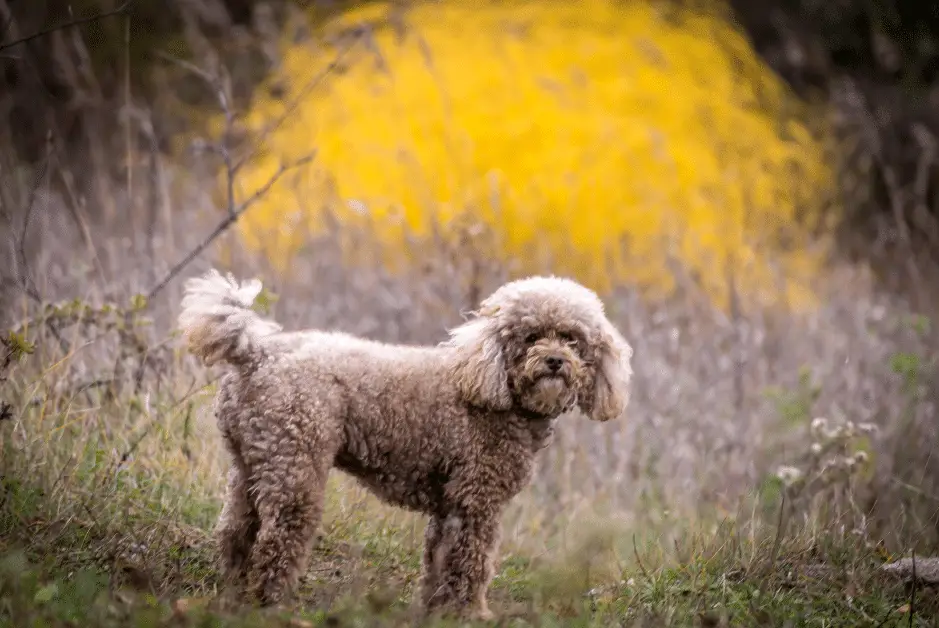The miniature poodle is a cheerful and curious pet with a hilarious disposition. These dogs are one of the smartest breeds in the world. They are easy to train and catches on to new commands pretty fast. That is why poodles can be seen in the circus more often than other breeds.

With regular walks, cute pets feel great in the apartment, adore all family members, and easily get along with children. They love to express their emotions. The miniature poodle communicates joy, surprise, or fear to the owner with loud, sonorous barking. Not everyone likes it, but the pet’s cute appearance and kind heart fully compensate for its vociferousness.
What Will You Learn? 👇
what were miniature poodles bred for
Miniature poodles were originally bred in Germany as water dogs. They were used to retrieve ducks and other birds that had been shot by hunters. The poodles were bred to be small so that they could easily swim in the water and not disturb the ducks.

Read our Smart Poodles - Smart Tricks eBook for only $2.99
Dive into a treasure trove of engaging tricks and tips designed specifically for your poodle!
Description of the miniature poodle breed
According to the approved FCI (Federacion Cynologique Internationale) standard, the miniature poodle reaches a height of 28-38 cm (11″-15″) at the withers. He should be fit, with soft curly hair, a beautifully proportioned head, and long, drooping ears.
Forefeet should be straight, parallel, and well-muscled. The tail is set high, and the body is harmonious and slender. A short tail is a sign of a genetic pedigree defect. Adult dogs weigh about 7 to 8 kg (10 to 15 pounds). At puppyhood, pets may be slightly overweight, but with age, they acquire the breed’s inherent slenderness and leanness.

One of the distinguishing features of the poodle is its unusual coat. It is very soft and thick, silky, and curly. Dense, shiny curls do not fade when touched or stroked. Also, representatives of the breed may have a cord-type hair coat, vaguely resembling human dreadlocks.
All colors except brown have black or dark brown eyes. The eyes of a brown poodle are pale amber or honey in color. It’s worth noting that according to the standard, the color should be uniform throughout the body.
Miniature Poodle Temperament & Personality
The miniature poodle is a cheerful and friendly pet that gets along well with the owner and his family. He easily reflects the mood and understands when to play and when to sit quietly and not interfere. Poodles are very easy to learn, be it commands or games.
The pet loves active games and new spaces and is moderately friendly to new people. Poorly tolerates loneliness, likes to be in the spotlight. At the same time, the thoroughbred poodle will calmly wait for the owner from work without creating disorder or noise in the apartment. If you pay enough attention to the miniature poodle in your family, he will quickly make friends with other pets.
A well-bred miniature poodle will maintain balanced neutrality with stranger dogs on a walk. These dogs do not like fights and brawls, preferring companionship. If the partner is not interesting or attractive to him, the poodle will simply ignore him. Aggression, as well as fear, are not peculiar to these dogs. Their presence may indicate serious mental or upbringing problems.
Despite their active and cheerful disposition, miniature poodles do not tire the owners. They are very tactful, and besides, they like to sleep. Even for adult dogs of this breed, it is normal to sleep up to 13 hours a day.
Are Miniature Poodles Good with Children?
Mini poodles get along well with children. They will be happy to play with them and even guard them. It is a companion dog, but it perceives the training of protective qualities as a fun and useful game. When communicating between a dog and a child, it is worth making sure that too young children do not injure the animal. In comparison, adults should respect the dog’s needs, its daily routine, and sleep.
Poodles can react sharply to loud and harsh sounds. It is worth informing the children about this, and then their communication with the dog will bring only positive emotions.
Miniature Poodle Health

Representatives of the breed have quite good health. They rarely get sick and have almost no bone problems that are common in other miniature breeds. Among the diseases that the miniature poodle is susceptible to, various eye pathologies can be distinguished. Also, these dogs have a tendency to food allergies (which are controlled by proper nutrition), osteochondrosis, and diabetes. In rare cases, pets of this breed may suffer from epilepsy or dysplasia of the elbow and hip joints. They also have a tendency to bloat, so it is essential to follow proper nutrition.
Representatives of the breed are sensitive to various parasites. Therefore, they need to be vaccinated in a timely manner and treated with protective agents. You should pay particular attention to the dog’s ears and eyes. The eyes must be dry and clean. A discharge may indicate infection, injury, or poor diet. The ears should also be dry, with no black wax or other discharge. If your dog scratches them too often, see your veterinarian to rule out an infection or foreign body.
Recent veterinary studies provide important insights for Miniature Poodle owners. Research has shown that poodles, including miniatures, may have certain breed-specific health concerns.
For instance, studies have highlighted issues like liver health, genetic conditions such as bleeding disorders. Dental health is also crucial, with research pointing to enamel defects in some poodles.
Moreover, understanding genetic risks for diseases like hypoadrenocorticism and hereditary cataracts is vital for proactive care. These insights can help owners maintain their Miniature Poodles’ health effectively.
With proper care and nutrition, the miniature poodle will be a real long-liver and will live at least 15-18 years. From early childhood to old age, these dogs do not lose vitality and innate curiosity.
Miniature Poodle pros and cons
The miniature poodle is a dog that will melt even the toughest heart. This pet is smart, funny, and extremely tactful. Seeing that his owner is busy or tired, he will not demand attention and will wait for a more convenient moment.
The advantages of this breed:
- Subtle and reasonable mind. The poodle is rightfully ranked second in intelligence and learning ability among dogs.
- Good health. The pet has good immunity and good health, which should be maintained with treatment for parasites and regular vaccinations.
- Friendly nature. Representatives of the breed are happy to meet guests, get along with children and other pets.
- Charisma and ability to please the owner. The dog’s bright aristocratic appearance and habits attract attention and bring coziness and positiveness into the home atmosphere.
- No shedding. The miniature poodle practically does not shed. Moreover, the breed has no undercoat. This means that even people prone to allergies can own it.
In addition to exceptional advantages, poodle breeders also note such disadvantages as:
- The need for regular grooming and groomer services.
- Conservative: the miniature poodle has a hard time changing lifestyle or changing owners.
- Hereditary diseases. You can avoid this by buying a puppy from a proven kennel.
- A tendency to food allergies and gastrointestinal diseases with improper diet.
- The need for regular (at least twice a day) walks.
Also, the love of barking is often associated with the breed’s faults. Poodle pups love to “talk” with sonorous barks. They also react to any noise outside. From an early age of your puppy, you should create your own command to teach him to stop barking and practice it repeatedly.
Care and grooming

For health and good mood, a poodle needs proper nutrition, daily walks in the fresh air, a comfortable sleeping place, grooming, and, of course, the owner and family members’ attention. For preventive examinations, you must visit a veterinarian at least once a year and not forget about the vaccination schedule against infectious diseases and rabies.
The curly hair of poodles is the calling card of the breed. This requires special attention. Due to its structure, fallen hair often gets tangled. To prevent this from happening, the pet should be combed out daily with a special brush or comb.
Since the miniature poodle practically does not shed, it needs a regular haircut at least once every two to three months. This procedure will not only simplify caring for your pet but will also create a bright and noticeable appearance. There are many different types of poodle haircuts, the most popular of which is the “Lion.” You can often see it at exhibitions or in circus performances. The back of the pet’s body is cut off, a lush “lion’s mane” remains on the head, and woolen pompoms on the tail and paws. Also, poodles are often cut in the so-called “English” style (different from the “Lion” haircut by a thicker mane on the head and neck) or “like a teddy bear” when the hair is neatly trimmed, creating the effect of a teddy bear teddy coat.
If the pet does not participate in exhibitions, you can choose a classic hygienic or sports haircut. You can cut a poodle yourself at home if you have experience and a special clipper. These dogs tolerate hygiene and cosmetic procedures well, while in the process, they behave calmly and obediently.
In addition to grooming and brushing your pet daily, you need to bathe at least once a month. After bathing, the wool should be well patted with a towel, gently combed, and dried with a hairdryer. Feet should be washed after every walk and dried with a towel.
Are miniature poodles smart?
Yes, miniature poodles are very smart. They are ranked as the second most intelligent dog breed, just behind the border collie. Miniature poodles are highly trainable and excel in obedience and agility competitions. They are also known for their hypoallergenic coat, which makes them a popular choice for people with allergies.
how much does a mini poodle cost
A mini poodle typically costs between $500 and $1,500. Some breeders may charge more or less depending on the specific type of mini poodle, the colors available, and whether the dog is show quality or not. Puppy mills and pet stores tend to charge more for mini poodles than responsible breeders.
Miniature poodle puppies
The miniature poodle is a breed with good health and a well-balanced psyche. However, this is only on the condition of high-quality breeding and origin from healthy adequate parents. Only a proven kennel can give such offspring. Therefore, it is better to buy a puppy with a pedigree and documents from experienced breeders who will advise nutrition and care. The cost of a puppy will vary depending on the class. The cheapest pet is considered a class pet, and you will have to pay twice as much for a show class pet.
When choosing miniature poodle puppies, you should pay attention to the appearance and behavior. Puppies should be active and balanced. If a puppy of this breed is healthy, he is constantly exploring something, sniffing, and considering everything new with interest. The coat should be uniform in color and texture, as well as clean and shiny. The nose is wet, the eyes are clean, and the stomach is not swollen. There is a recommendation to choose the most active puppy from the litter, but you can give preference to the one that will choose you.
Marko is the founder and author at PoodleHQ, where he blends profound expertise with formal training in Animal Behavior and Canine Genetics. With multiple generations of poodles under his care, he’s a breed connoisseur, honored with the Canine Care Excellence Award and lauded by the International Pet Enthusiasts Association.


Great article!